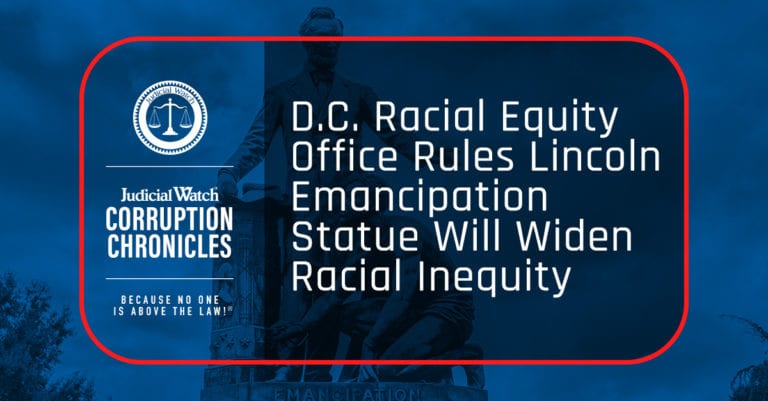
D.C. Racial Equity Office Rules Lincoln Emancipation Statue Will Widen Racial Inequity

A government office launched recently to eliminate racial disparities and achieve racial equity in Washington D.C. has determined that installing an Abraham Lincoln Spirit of Freedom Emancipation Statue at the African American Civil War Museum will widen racial inequity even though the council unanimously voted for it and the mayor supports it. In fact, Mayor Muriel Bowser urged the D.C. Council to pass the resolution, known as PR 24-0238, approving the statue’s installation on the public space adjacent to the museum in the historic Archibald Grimke School at 1925 Vermont Avenue, NW.
In a May 14, 2021 letter to D.C. Council Chairman Phil Mendelson, the mayor refers to the project as “commemorative work” and writes that the Lincoln statue was delivered in July 2020 and the museum has filed the necessary paperwork to obtain a permit from the Department of Transportation to install it. Bowser reveals the piece was designed to create a sightline across Vermont Avenue from the Memorial to the Museum at Grimke, which is currently under construction, and it will rest on a podium adorned by ceremonial steps. “I urge the Council to take prompt and favorable action on the enclosed resolution,” Bowser writes, referring to the measure attached to her letter. On June 29, the council passed it by a vote of 13-0.
Nevertheless, a special D.C. panel created to tackle racism, the Council Office of Racial Equity (CORE), has nixed the idea, writing in a report that “Lincoln’s legacy has long been debated” and the statue will not increase representation of communities of color. The five-page document, officially called Racial Equity Impact Assessment (REIA), delves deeply into the supposed lack of diversity among statues and commemorative works in D.C. and offers a simple conclusion involving the new Lincoln fixture: “Although the overall impact on residents’ lives will be minimal, PR24-0238 would contribute to widening the racial inequity between the number of commemorative works dedicated to white men and those dedicated to Black persons and other persons of color in the District of Columbia.”
The CORE report seems to scold D.C. officials, stating that “commemorative works should be intentional about who is being honored, why they are being honored, and how that representation will inspire future generations.” Under the large, bold heading of “RACIAL EQUITY CONSIDERATIONS” the race council writes that there are at least four statues and commemorative works honoring President Lincoln’s legacy, “which has long been debated,” throughout D.C. It singles out the Emancipation Memorial for being funded by “formerly enslaved men and women” who had no say in the matter. “There is a severe lack of diversity amongst statues and commemorative works in the District of Columbia,” the CORE racial equity assessment states. “In 2019, of at least 115 statues in DC, just six were of American women and only one was of a Black woman, that being Mary McLeod Bethune. Duke Ellington was the only Black native Washingtonian with a statue dedicated in his honor.” Erecting yet another statue of Lincoln underscores the need to close the existing gap, the panel writes.
CORE was established this year as part of a broader measure called Racial Equity Achieves Results Act (REACH) enacted to establish a racial equity framework across the entire D.C. government. REACH requires mandatory racial equity training for D.C. government employees, the creation of a Commission on Racial Equity, Social Justice, and Economic Inclusion as well as racial equity impact assessment on certain council measures. The law also requires the mayor to include racial equity performance measures in the development of an agency’s annual performance plans and creates a racial equity tool to help all D.C. agencies incorporate racial equity into their operations, performance-based budgets, programs, polices, rules and regulations.
CORE is tasked with eliminating racial disparities and achieving racial equity by determining if proposed D.C. laws and policies advance racial equity or increase racial inequity. The panel accomplishes this by conducting a REIA like the one completed for the new Lincoln statue. REIA is described on the agency’s website as the careful and organized examination of how different racial and ethnic groups will likely be affected by a proposed bill or resolution. “A REIA can help prevent institutional racism, deconstruct structurally racist policies, and identify historic and structural causes of long-standing racial inequities,” according to CORE. It is not clear if the D.C. Council will move forward with the Lincoln statue installation or reverse course over CORE’s findings.















